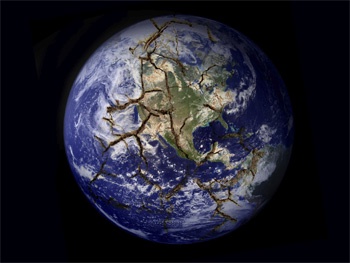From oil fields and meteorite impact craters, to potential tsunami triggering submarine landslides, innovative new technology which provides images from below the Earth’s surface has been unveiled.
The Virtual Seismic Atlas (VSA) website allows scientists access to geological pictures and information, to enhance research into understanding the Earth's structure and natural resources.
The seismic images available on the website reveal astounding geological insights, in particular of the seabed, that include mud volcanoes and massive submarine landslides that could possibly trigger tsunami waves.
The website, which is free to use, is the world's first to link data with interpretation, making crucial seismic images available to experts and non-specialists alike.
The development of the VSA website is a collaborative project between the University of Aberdeen and the University Leeds funded by the Natural Environment Research Council in partnership with a consortium of energy organisations. Crucial input to the website was provided by key multinational oil and gas companies, seismic companies and geological surveys.
From North Sea oil field structures to submarine canyons in offshore Nigeria and mud volcanoes from the Caspian Sea, the technology provides key seismic data for research and training purposes.
The technology will open up access to this crucial information to a worldwide audience as Rob Butler, Professor of Tectonics at the University of Aberdeen explains: "Traditionally this important geological images and information was extremely exclusive, only accessible by a limited group of scientists. The VSA website will enable students, professionals and members of the public to view these exciting images which illustrate what lies below the Earth's surface.
"This is extremely significant not only in terms of academic and research developments, but also in enhancing the understanding of earth science within the wider community."
Seismic images are used within the oil and gas industry to help organisations detect oil reservoirs. This data is generated through controlled explosions which reflect energy back from rocks, allowing areas where natural resources can be found to be identified.
Professor Butler continues: "Seismic data is integral to the oil and gas industry and the information which is collected by the sector is humanity's greatest resource of geophysical data in terms of both volume and financial investment.
"The VSA website will make access to this information simple in a way which has never been possible before. Digitally collating seismic data and bringing the information together in this way will allow for improved research and simpler cross-referencing of information. The design of the website also involves an on–line community aspect which means the bank of available images will grow organically over time."
Professor Bill McCaffrey, University of Leeds School of Earth and Environment says: "The sort of data we are releasing to the public is usually very difficult to obtain for scientific research. Yet it is our primary source of geological information about the top 10-20 km of the Earth's crust."
Visit the Virtual Seismic Atlas (VSA) at www.seismicatlas.org.


